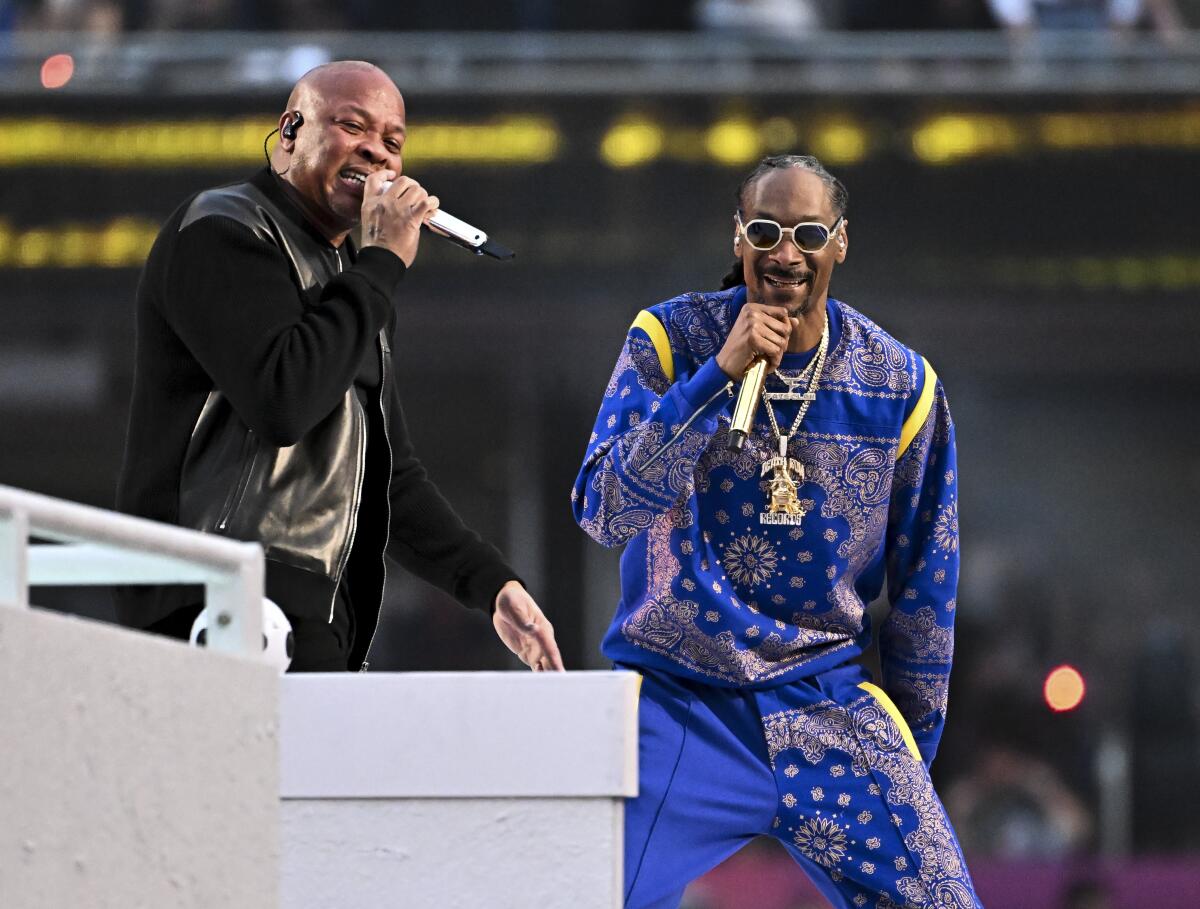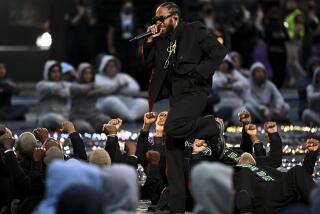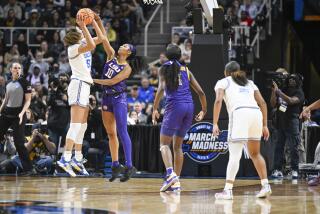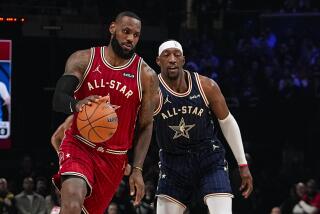Feedback: Many loved Super Bowl LVI’s halftime show. These readers did not

- Share via
Not fans at halftime
Most of us look forward to the halftime show at the Super Bowl. Pop music critic Mikael Wood described this year’s as “an all-time great show” [“Hip-Hop Giants Came to Play,” Feb. 14].
I personally was appalled. There was no beauty, no grace, or for that matter no melodious music. Just people jumping up and down holding their crotches and yelling words too hard to understand, even with subtitles.
For the record:
2:24 p.m. Feb. 17, 2022An earlier version of this post credited a letter to Sandra Hernandez of the Mexican American Legal Defense and Educational Fund. It was written by that group’s president, Thomas A. Saenz.
How disappointing. Can’t we do better than this, so that all of us can enjoy a show that represents many diverse acts?
Jackie Chapkis
Woodland Hills
::
Music critic Michael Wood has the audacity to suggest that hip-hop is America’s music.
Music is defined as “vocal or instrumental sounds combined in such a way as to produce beauty of form, harmony and expression of emotion.”
The hallmarks of Sunday’s halftime performances were indecipherable lyrics and nonexistent melodies. Composers from George Gershwin to Johnny Mercer to Paul McCartney to Stephen Sondheim probably rolled over in their graves.
Noel Johnson
Glendale
Editor’s note: Paul McCartney is not dead.
::
Will someone tell me what Dr. Dre was saying? I didn’t understand a word of it. And that’s what we’re told to believe is the future of music.
Lew Aaronson
Culver City
Stadium views
In her column, Carolina A. Miranda [“Even Its Cheap Seats Are VIP,” Feb. 8] writes that the uppermost seats at Sofi Stadium “may be high up, but you never feel far from the action.”
I have been a season ticket holder in these nosebleed seats for two years now and I can assure you that is far from the truth. Our seats are so far away from the action on the field that we have problems picking up the football on kicks and pass plays. We can see the quarterback start to throw the ball on a pass play and the next thing we see is the receiver being tackled.
I was unable to see the play where the San Francisco 49er quarterback threw the interception that essentially ended the game. Someone in my section yelled out that it was a safety, which it was not.
I am extremely unhappy with these nosebleed seats.
Earl M. Hyman, lifelong Rams fan
Los Angeles
::
Carolina A. Miranda’s articles [on SoFi Stadium] to date have been excellent.
I am looking forward to reading about the accommodations for the disabled and people of limited abilities at SoFi Stadium.
Ann R. Johnson
Oxnard
::
It seems obvious that Mia Lehrer is the one to design the L.A. River [“From the L.A. River to SoFi Stadium” by Carolina A. Miranda, Feb. 13]. She’s great — hire her now and fund her plan.
Lore Spangler
Los Angeles
What’s for sale?
In regard to television critic Lorraine Ali’s story about Super Bowl ads [“Star Power Out in Force in Ads,” Feb. 14]: For too many of these ads, lost in the special effects and star power of celebrities is the product or service advertised. We see the name for a split second at the end of the commercial, seemingly as an afterthought. No mention of product features or what it’s for.
For obscure advertisers needing and wanting the exposure that the Super Bowl offers, it’s a lost opportunity and very expensive for production costs and air time.
The creative people at the ad agencies probably don’t care. They are after the recognition and admiration of their peers. They compete to see who can produce the funniest and most entertaining 30 or 60 seconds.
I blame the clients for allowing their ad agencies to spend all this money without a significant return.
James Landon
Apache Junction, Ariz.
Something witty this way comes…
Regarding “Oscar Nominations: Family Affairs” [Feb. 9]: Glenn Whipp’s witty comment regarding the failure of “The Tragedy of Macbeth” to get a best picture nomination (“‘Something wicked this way comes’ pretty much sums up just about every Oscar nominations announcement, don’t you think?”) pretty much sums up why Whipp is my favorite L.A. Times entertainment writer, bar none.
Steve Abramson
Valencia
Art vs. the artist
When I read Justin Chang’s movie reviews, which are often very good, I want to know what he thinks of the film he’s reviewing, not what he thinks of the actor’s personal life or whether the filmmaker should have hired the actor because of it.
I found it inappropriate and indeed offensive to read his rant about Armie Hammer’s alleged abusive treatment of women featured in his review of “Death on the Nile” [“A Float Down Denial River,” Feb. 11], with the not-so-subtle suggestion that filmmakers should consider not hiring him.
In my opinion, Chang should stay in his lane and leave controversial social issues to others. Enough with the cancel culture.
Alvin S. Michaelson
Marina del Rey
::
I have always admired and looked forward to Justin Chang’s film reviews, but I found all his verbal handwringing over Armie Hammer’s appearance in Kenneth Branagh’s “Death of the Nile” uncharacteristically unfair, not to mention short-sighted.
Hammer has offered superb performances in adventurous films such as “The Social Network” and “Call Me By Your Name,” and deserves simply an appraisal of his work in the film in question, not speculation on how the actor’s off-camera activities might or might not resonate with audiences.
I would remind Chang that over two decades ago, two other “Hollywood golden boys” (Rob Lowe and Hugh Grant) were caught in sexual scandals that did no long-term damage to their careers.
And I would remind everyone that Hammer has been accused of sexual assault, not charged or convicted.
Bill Royce
Cathedral City
What’s wrong with these pictures?
Regarding the online gallery “The Take: Faces in the Crowd of an Exclusive Super Bowl Party at SoFi Stadium” by Allen J. Schaben [Feb. 13]: The Times has once again performed its favorite magic trick — disappearing half the local population —by publishing a photo array that includes no one from the largest racial/ethnic group in the area, Latinos, who comprise half the population of the county.
Yet, as always, the editors, who characterize the photos as a “cross-section of L.A.,” scrupulously ensured that three other groups — each smaller in size than the Latino population — are included: whites, Blacks and Asian Americans.
Though I think this particular magic is hackneyed and self-destructive, I still must ask how you accomplish this trick? In this case, did you select the specific party to feature because it would have no Latino guests, or did you have to instruct your photographer to avoid any Latinos in attendance?
Do you think The Times’ consistent and obvious discrimination influences publicists to exclude Latinos as they put together events?
Thomas A. Saenz,
Mexican American Legal Defense and Educational Fund
Los Angeles
To submit a letter, email: [email protected]. Include your name and city of residence. Letters are subject to editing for space and content considerations.
More to Read
The biggest entertainment stories
Get our big stories about Hollywood, film, television, music, arts, culture and more right in your inbox as soon as they publish.
You may occasionally receive promotional content from the Los Angeles Times.










